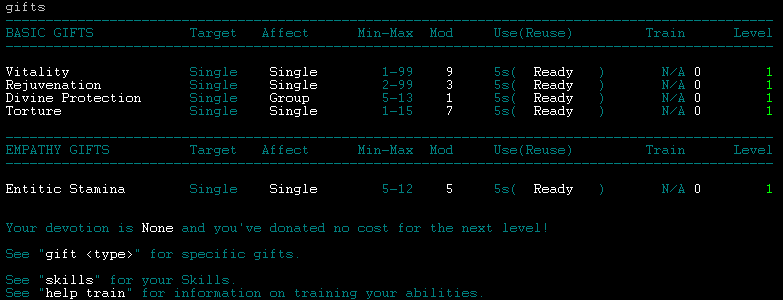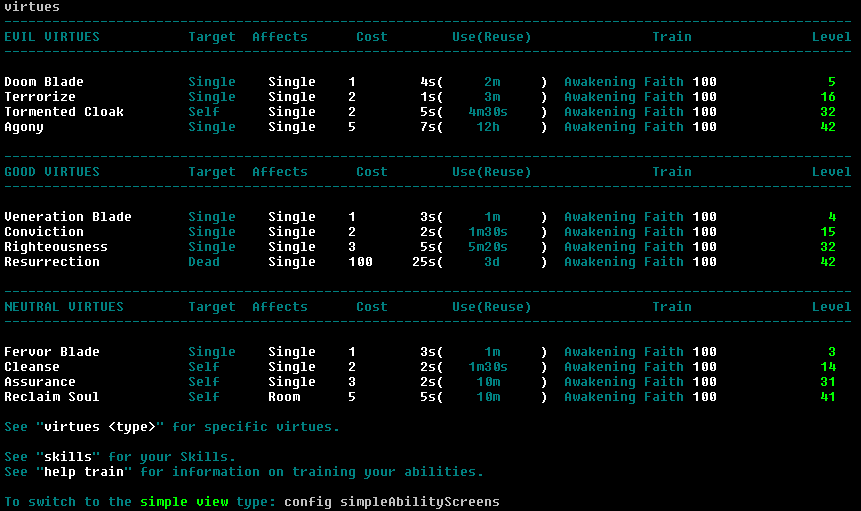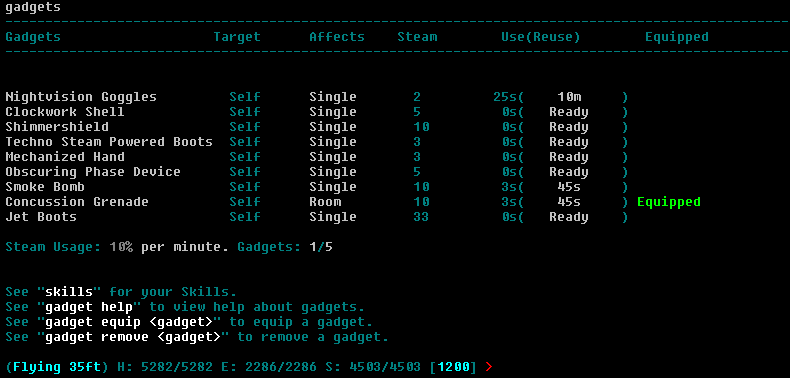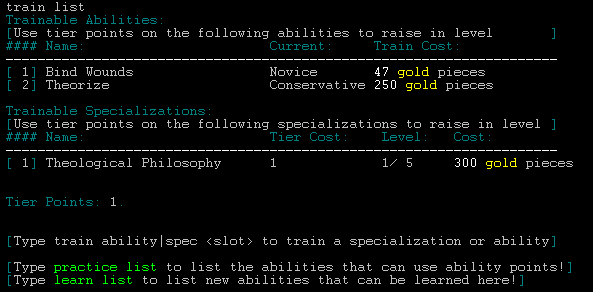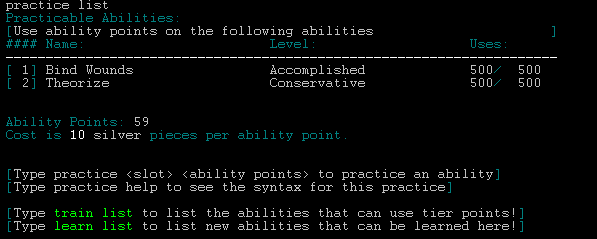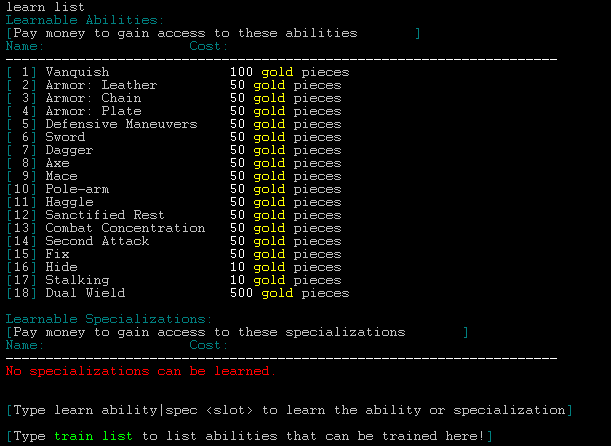There are many abilities in A Tempest Season. Abilities consist of skills, spells and gifts. Each ability has a certain function and levels. The following page will explain how they work.
Contents
Viewing Abilities
To view your abilities type one of the following commands:
For skills: skills
For spells: spells
For gifts: gifts
For virtues: virtues
For gadgets: gadgets
Skills
The following image displays the skill screen:
This table explains each column:
| Column | Description |
| Skills | The name of the skill. |
| Target | The valid target type: single target, self only, etc Note: Passive and Auto cannot be used directly. |
| Affects | The area of affect for this skill: single, group, etc. |
| Stamina | The stamina cost of the skill. |
| Use(Reuse) | Use: The number of seconds you’re in delay for using the skill. Reuse: The duration this cannot be used. Most skills have short reuse times, but some more powerful ones have very long reuse times. |
| Train | Many skills have levels associated with them but not all do. The first word in cyan is the skill level (ie: Godly or Novice). The second part in white, are the number of uses left before it can be leveled up. Note: It is not a requirement to reach 0 uses in order to level up a skill. |
| Level | The required character level for this skill. Green indicates you can use it, and red indicates you cannot. |
Important!
The skill screen has a Simple Mode, which greatly reduces the information displayed.
To set the simple mode type:
config simpleAbilityScreens
Spells
The following image displays the spell screen:
This table explains each column:
| Column | Description |
| X SPELLS | The category of the spells – in this example Fire spells are displayed. |
| Target | The valid target type: single target, self only, etc Note: Passive and Auto cannot be used directly. |
| Affects | The area of affect for this spells: single, group, etc. |
| Drain | The essence and elemental charge cost of the spell. The color indicates the charge type and the + or – indicates if a charge is added on use or subtracted. In the above, Fire Bolt takes 10 essence and adds 1 fire charge. Fire ball takes 20 essence and requires 2 fire charges to cast. |
| Use(Reuse) | Use: The number of seconds you’re in delay for using the spell. Reuse: The duration this cannot be used. Most skills have short reuse times, but some more powerful ones have very long reuse times. |
| Train | Many spells have levels associated with them but not all do. The first word in cyan is the spell level (ie: Godly or Novice). The second part in white, are the number of uses left before it can be leveled up. Note: It is not a requirement to reach 0 uses in order to level up a spell. |
| Level | The required character level for this spell. Green indicates you can use it, and red indicates you cannot. |
Important!
The spell screen has a Simple Mode, which greatly reduces the information displayed.
To set the simple mode type:
config simpleAbilityScreens
Gifts
The following image displays the gift screen:
This table explains each column:
| Column | Description |
| X GIFTS | The category of the gifts – in this example Basic gifts are displayed. |
| Target | The valid target type: single target, self only, etc Note: Passive and Auto cannot be used directly. |
| Affects | The area of affect for this gift: single, group, etc. |
| Min-Max | The minimum and maximum amount of favors that can be spent on this gift. |
| Mod | For each favor spent above the min, the gift will increase in by power # points. For example, Vitality will heal an extra 9 health per point spent over 1. |
| Use(Reuse) | Use: The number of seconds you’re in delay for using the gift. Reuse: The duration this cannot be used. Most gifts have short or no reuse times, but some more powerful ones have very long reuse times. |
| Train | Most gifts do not have levels associated with them but some do. The first word in cyan is the spell level (ie: Godly or Novice). The second part in white, are the number of uses left before it can be leveled up. Note: It is not a requirement to reach 0 uses in order to level up a spell. |
| Level | The required character level for this spell. Green indicates you can use it, and red indicates you cannot. |
In addition, the gift screen shows the progress to the next donation level for Clerics.
Warning!
The gift screen does not have a simple view, due to the integral information the gift screen provides.
Virtues
The following image displays the virtue screen:
This table explains each column:
| Column | Description |
| X VIRTUES | The category of the virtues: Good, Neutral and Evil. |
| Target | The valid target type: single target, self only, etc Note: Passive and Auto cannot be used directly. |
| Affects | The area of affect for this virtue: single, group, etc. |
| Use(Reuse) | Use: The number of seconds you’re in delay for using the virtue. Reuse: The duration this cannot be used. Most virtues have medium length reuse times, but some more powerful ones have very long reuse times. |
| Train | Virtues have levels associated with them, increasing their power. The first word in cyan is the virtue level (ie: Awakening Faith). The second part in white, are the number of uses left before it can be leveled up. Note: It is not a requirement to reach 0 uses in order to level up a spell. |
| Level | The required character level for this spell. Green indicates you can use it, and red indicates you cannot. |
Gadgets
The following image displays the gadget screen:
This table explains each column:
| Column | Description |
| Gadgets | The name of this gadget. |
| Target | The valid target type: single target, self only, etc Note: Passive and Auto cannot be used directly. |
| Affects | The area of affect for this gift: single, group, etc. |
| Steam | The amount of steam this takes on use or each minute. |
| Use(Reuse) | Use: The number of seconds you’re in delay for using the gadget. Reuse: The duration this cannot be used. |
| Equipped | If this gadget is equipped or not. |
Each gadget adds to the passive upkeep cost. This is calculated each minute and drained from your personal steam generator. See the section on Using Gadgets for more information!
Simple View Mode
A simple mode can be turned on or off for the Skill and Spell screen by typing:
config simpleAbilityScreens
This mode greatly reduces the amount of information displayed:
Using Abilities
The following explains how to use skills, spells and others. Each are slightly different.
Many ability names can be abbreviated, most often, using the first character.
Example:
If the spell “Crystallized White Out” was known, the following could be typed:
cast crystallizedwhiteout stalker
cast cry stalker
cast cr stalker
cast c stalker
Important!
Experiment to see how short you can make your ability names!Skills
Using a skill is easy to do. There are two ways to do so:
- Type: use <skillname> <target>
- Example: use dropkick dayrinni
- Type: ‘skill name’ <target>
- Example: dropkick dayrinni
Important!
The game will perform an automatic lookup for skills if an invalid command was detected. The majority of skill names are invalid game commands.Important!
To use a skill that has multiple words in it, type the name without spaces. For example: use dropkick dayrinni..Spells
Using a spell is easy to do.
Type: cast spellname <target>
Important!
To use a spell that has multiple words in it, type the name without spaces. For example: cast fireball dayrinni.
Gifts
Using a gift is easy to do.
Type: pray <gift name> <target> [<favors>|min|max]
Clerics need to specify the amount of favors they’re using on each gift. Each gift has a minimum and maximum amount of favors. The amounts can be seen on the gifts command. To make it easier on the Cleric, the max word can be used to fully pump up a gift.
Important!
To use a gift that has multiple words in it, type the name without spaces. For example: pray holyarmor dayrinni min
Virtues
Using a virtue is easy to do.
Type: unleash <virtue name> <target>
Templars need to have the correct amount of favors and meet the necessary alignment requirements. You may only use Good virtues while in a Good alignment, Neutral in a Neutral Alignment (except Fervor Blade) and Evil in an Evil alignment.
Important!
To use a virtue that has multiple words in it, type the name without spaces. For example: unleash reclaimsoul dayrinni
Gadgets
First, a gadget must be equipped before it may be used.
To equip a gadget, type: gadget equip < gadget name>
For example, gadget equip Wrist Gun would equip the clockwork wrist gun, a powerful steam based weapon.
Once a gadget is equipped, such as the wrist gun above, it must be cranked to fire it:
Type: crank <gadget> <target>
For example, crank wristgun dayrinni would fire the gun at Dayrinni.
Cranking Steam
Steam is used to power the Agents gadgets Any equipped gadget takes steam which is drained every minute by a %. The more gadgets equipped, the stronger the drain. Additionally, gadgets take some steam upon activation (passive gadgets do not).
To restore a percentage of steam to your personal generator, type:
crank steam [value%]
This will restore the indicated value as a %. If left blank, the amount restored will be 100%.
Training Abilities and Specializations
As you adventure, your abilities and specializations will be able to raise up in level. To train an ability or specialization to the next level visit the trainer in Tralisia.
To view the screen to see what abilities can be trained type: train list
In the above, several skills can be trained to the next level: defensive maneuvers, fanaticism, fix and several others. Each ability costs gold and sometimes a tier point to raise up in level.
To train an ability to the next level type: train ability <slot>
To train a specialization to the next level type: train spec ‘<slot>
For example: train ability 1 would train the Bind Wounds skill to the next level.
Training Cost
As mentioned above, the cost to train an ability or specialization requires gold and sometimes a tier point.
Tier Points
Tier points are used to level up abilities and specializations.
Not all abilities require a Tier Point but all specializations do. To determine if an ability requires a tier point, view the train cost by typing, at the trainer:
train list
Important!
Generally, the first few levels of an ability does not require a Tier Point – only the higher levels do!
Gaining Tier Points
There are many ways to gain tier points, which are explained below.
Leveling Up
Tier points are gained during level up of your character’s normal level. Some classes receive extra tier points throughout their advancement, which is based on the number of abilities they ultimately receive. Mages, Rogues and Arcanist gain an extra tier point every 5 levels.
For example, going from level 1 to 2 would grant you a single tier point.
Buying Tier Points
You may also buy up to 10 tier points at the trainer. Each tier point has a cost, starting from 500 gold to 3,500 gold for the last point.
To check the cost of a tier point type:
train tier cost
To buy the tier point type:
train tier buy
Questing Tier Points
Some quests award tier points upon completion – so go out and explore! The dynamic quests offered by Dar’larna also have a small chance to award a tier point. She can be found in the Swordspire Training Hall, west of the center of town.
Maximum Level Tier Points
At level 100, all experience gained by your character goes into generating tier points. There is no limit to the amount of tier points earned.
Important!
Remember, you can earn any amount of tier points long term. So feel free to experiment after you reach the maximum level!Currency Cost
Many abilities require a currency cost to level up. If the ability has uses, this cost will be prorated against the remaining amount.
For example, if a skill has 50 out of 100 uses, the cost would be reduced by 50%!
Important!
If you’re short on currency, it may be cheaper to practice your abilities to gain uses to lower the training currency cost!Notice
Not all abilities have uses. Specializations do not have uses and thus their cost cannot be lowered in this manner.Ability Levels
Abilities that can be trained have levels associated with them. The average amount of levels is 3, 5 and 10. To see the maximum level of an ability, see its help file.
The following are the lists of adjectives used:
Novice Spells
| Apprentice |
| Adept |
| Master |
Advanced Spells
| Apprentice |
| Adept |
| Skilled |
| Supreme |
| Arcane Master |
Basic Abilities
| Novice |
| Accomplished |
| Proficient |
| Veteran |
| Expert |
Advanced Abilities
| Novice |
| Accomplished |
| Proficient |
| Professional |
| Veteran |
| Expert |
| Master |
| Legendary |
| Mythical |
| Godly |
Other
There are some abilities that follow different adjectives for their levels, such as Shard Construction. However, the vast majority of the abilities in the game use the above.
Resetting Tier Points
You may reset your characters tier points at the trainer for 5,000 gold. When doing so, all of your non-natural abilities and specializations will be set to level 1.
You will receive all of your spent tier points and 75% of the spent ability points as a refund.
Your Natural abilities will remain the same.
To reset your tier points while at the trainer type:
train tier respec confirm
Important!
If the refunded ability points go over your maximum capacity you will remain above the the maximum capacity until they are spent.Practicing Abilities
Another way to practice your abilities besides using them is paying the trainer a small fee per use. The cost of each use is 10 silver. There can be cases were the ability cost can be quickly reduced by spending a small amount of gold.
Practicing abilities at the trainer requires ability points and silver.
Ability Points
Ability points are gained while leveling up your character’s level and killing monsters in combat. The more monsters killed, the more ability points you’re character acquires. These can be used to gain cheap uses at the trainer.
How to Practice at the Trainer
To find out what can be practiced, type: practice list
To practice an ability type: practice <slot> <amount of uses>
For example: practice 1 100 would practice Bind Wounds for 100 uses at a cost of 1,000 silver or 10 gold.
Remember, each ability point spent on an ability lowers the training cost.
Important!
It may be a good idea to practice an ability with 1 ability point and check how much the price drops by typing train list. It could be cheaper to use ability points before training!!Learning Abilities and Specializations
You may also learn new abilities and specializations. These can be learned at the trainer in Tralisia as well as from items in the game. The learn command is used to do this.
Learning at the Trainer
To view the abilities that can be learned, while at the trainer type learn list.
To learn a new ability simply type: learn ability ‘<slot>
To learn a new specialization simply type: learn spec <slot>
For example, learn ability 2
Important!
There are rare trainers found else where in the world. It may be a good idea to see if learn list works in any other places in the game…Learning from Items
It is also possible to learn new abilities and specializations from items, such as tomes, manuals, books and scrolls.
To learn from an item type: learn item ‘item name’
For example, learn item book
Important!
Mages learn spells and specializations from tomes from the Magic Shop located in the Merchant District.



